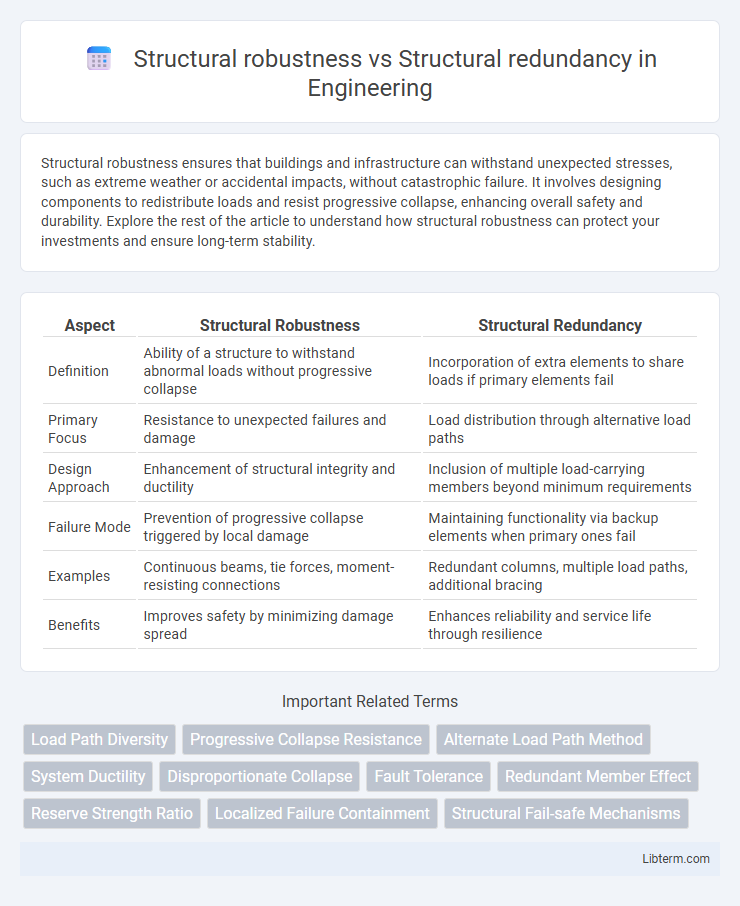Structural robustness ensures that buildings and infrastructure can withstand unexpected stresses, such as extreme weather or accidental impacts, without catastrophic failure. It involves designing components to redistribute loads and resist progressive collapse, enhancing overall safety and durability. Explore the rest of the article to understand how structural robustness can protect your investments and ensure long-term stability.
Table of Comparison
| Aspect | Structural Robustness | Structural Redundancy |
|---|---|---|
| Definition | Ability of a structure to withstand abnormal loads without progressive collapse | Incorporation of extra elements to share loads if primary elements fail |
| Primary Focus | Resistance to unexpected failures and damage | Load distribution through alternative load paths |
| Design Approach | Enhancement of structural integrity and ductility | Inclusion of multiple load-carrying members beyond minimum requirements |
| Failure Mode | Prevention of progressive collapse triggered by local damage | Maintaining functionality via backup elements when primary ones fail |
| Examples | Continuous beams, tie forces, moment-resisting connections | Redundant columns, multiple load paths, additional bracing |
| Benefits | Improves safety by minimizing damage spread | Enhances reliability and service life through resilience |
Introduction to Structural Robustness and Redundancy
Structural robustness refers to a building's ability to withstand and adapt to unexpected loads or damages without collapsing, ensuring overall safety and structural integrity. Structural redundancy involves incorporating multiple load paths within a design, so if one element fails, others can take over, preventing progressive collapse. Both concepts are essential in engineering to enhance resilience, with robustness emphasizing resistance to failure and redundancy focusing on backup mechanisms within the structural system.
Defining Structural Robustness
Structural robustness refers to the ability of a structure to withstand unexpected loads, damages, or failures without experiencing overall collapse or significant loss of function. It emphasizes the inherent strength and resilience of the structure's design to maintain stability under adverse conditions. Structural redundancy, by contrast, involves incorporating multiple load paths or backup elements to ensure safety if certain components fail.
Understanding Structural Redundancy
Structural redundancy refers to the intentional incorporation of additional elements or pathways within a structure to distribute loads and provide alternative load paths in case of component failure. This design strategy enhances safety and resilience, ensuring that the structure maintains its integrity even if one element becomes compromised. Understanding structural redundancy is crucial for optimizing load distribution and minimizing the risk of progressive collapse in engineering projects.
Key Differences Between Robustness and Redundancy
Structural robustness refers to a structure's ability to withstand unexpected loads or damage without significant loss of functionality, while structural redundancy involves incorporating multiple load paths so that if one component fails, others can share the load. Robustness emphasizes resistance to collapse under unforeseen conditions, whereas redundancy focuses on safety through duplication of structural elements. Key differences lie in robustness providing durability against unpredictable events, and redundancy ensuring continuous load-bearing capability through backup components.
Importance of Robustness in Structural Design
Structural robustness ensures a building can withstand unexpected loads or damage without disproportionate collapse, enhancing safety and longevity. Unlike structural redundancy, which relies on multiple load paths to distribute forces, robustness emphasizes resistance to failure through inherent strength and detail design. Prioritizing robustness in structural design minimizes risk from unforeseen events like earthquakes or impacts, making it critical for resilient infrastructure.
Role of Redundancy in Ensuring Safety
Structural redundancy enhances safety by providing alternative load paths, allowing a structure to remain stable even if some components fail. Structural robustness depends on this redundancy to prevent progressive collapse, ensuring that failure in one element does not result in catastrophic consequences. Effective design integrates redundancy to improve resilience against unforeseen loads and damage.
Case Studies: Failures Due to Lack of Robustness or Redundancy
Structural robustness ensures a building can withstand unexpected loads without catastrophic failure, while structural redundancy provides alternative load paths if one component fails. Notable failures like the 2007 I-35W Mississippi River bridge collapse highlight catastrophes resulting from insufficient robustness, and the 1995 Sampoong Department Store collapse in South Korea demonstrates the consequences of lacking redundancy. Case studies consistently show that integrating both robustness and redundancy is critical to prevent progressive collapses and improve overall structural safety.
Design Strategies for Achieving Robust Structures
Structural robustness is achieved by designing systems capable of withstanding unforeseen loads or damage without significant loss of function, focusing on material strength, load path continuity, and structural integrity. Structural redundancy involves incorporating multiple load-carrying elements so that if one fails, others can share the load, enhancing overall safety and reliability. Effective design strategies combine robust materials, strategic load distribution, and redundancy through redundant members or alternative load paths to ensure resilience against progressive collapse or unexpected structural failures.
Balancing Robustness and Redundancy: Cost and Performance
Balancing structural robustness and redundancy involves optimizing the trade-off between safety and cost efficiency in engineering designs. Robustness enhances a structure's ability to withstand unexpected loads or damages without significant performance loss, while redundancy provides alternative load paths to prevent collapse but often increases material and construction costs. Effective design strategies prioritize achieving sufficient robustness to minimize maintenance and unexpected failures, coupled with strategic redundancy to ensure safety, optimizing overall performance and budget constraints.
Future Trends in Structural Safety Engineering
Emerging trends in structural safety engineering emphasize integrating structural robustness with advanced structural redundancy to enhance overall resilience against unforeseen loads and progressive collapse. Innovations in smart materials and real-time monitoring systems enable adaptive responses within structural frameworks, improving redundancy effectiveness and robustness under dynamic stress conditions. The future of structural safety prioritizes predictive analytics and machine learning algorithms to optimize design strategies, blending robustness and redundancy for sustainable, failure-resistant infrastructure.
Structural robustness Infographic

 libterm.com
libterm.com